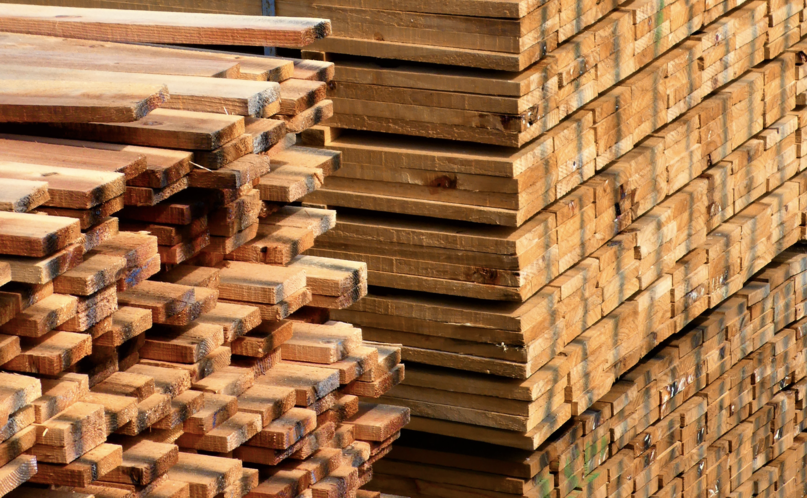Tropical log production, imports down in 2020—ITTO releases latest review of world timber situation
30 August 2021

Sawnwood at a yard in Yokohama, Japan. Photo: J. Claudon/ITTO
Yokohama, 30 August 2021: Tropical log production declined by 3% in 2020 due largely to the COVID-19 pandemic, and imports plummeted by 11%, according to ITTO’s Biennial Review and Assessment of the World Timber Situation 2019–2020, which was released today. The flagship report provides data on the production and trade of primary and secondary processed wood products in 73 countries worldwide.
Key findings of the report include the following:
- The impacts of the COVID-19 pandemic on tropical wood product production, consumption and trade varied in 2020, depending on the severity of the pandemic in individual countries and the steps taken to control and mitigate the spread of the virus. Demand in major tropical wood product markets also differed among countries, depending on the underlying economic conditions before the pandemic and the success of policy responses to the virus.
- Tropical log production in ITTO member countries totalled 294 million m3 in 2019, slightly higher than in 2018, with Indonesia, Brazil, India, Thailand and Viet Nam accounting for nearly three-quarters of this. Production declined by 3.1% in 2020, however, to 285 million m3, due to restrictions imposed in most producer countries in response to the pandemic, which affected harvesting operations and freight capacity. Labour and logistical restrictions had eased in many producer countries by the middle of the year.
- Tropical log imports by ITTO members have continued to decline from a peak in 2014. The volume dropped by 13% in 2019, year-on-year, to 14.5 million m3, and then by a further 16% in 2020, to 12.2 million m3, the lowest volume since ITTO began its assessments in 1987. The bulk of global trade continued to go to China and India, which together accounted for 83% of tropical roundwood imports in 2019, dropping to just over 81% in 2020.
- China’s tropical log imports contracted in volume by more than 11% in 2020, to 8.6 million m3, in response to a restricted supply of raw materials, increased freight rates, a reduction in processing activities in the first quarter of 2020, and an ongoing reduction in demand for processed wood products in export markets. With the COVID-19 virus effectively controlled by the end of the first quarter, however, the economy recovered more strongly in China than in other consumer countries, leading to a strong rebound in construction activity in the second half of the year and a resumption in imports.
- Papua New Guinea was the largest global exporter of tropical logs in 2020, although the volume declined by 23%, year-on-year, to 2.9 million m3, mostly destined for China. The country’s log exports are expected to continue declining over the next decade following the imposition of export restrictions in 2020 and government intentions to cease log exports by 2025. The reduced availability of logs from the Asia-Pacific region continues to put pressure on alternative tropical log supply sources, particularly from Africa but also, more recently, from Latin America and the Caribbean, where exports surged to 2.2 million m3 in 2020, nearly twice the level in 2016. Almost all this increase is from Brazil, with exports from that country totalling 1.4 million m3 in 2020. Brazil’s exports of tropical logs were negligible before 2018 and are comprised primarily of eucalyptus species.
- Tropical sawnwood exports declined by 10% in 2020, to 9.2 million m3, reflecting both supply and demand issues associated with the pandemic. China was the major importer by a large margin, accounting for 61% of ITTO imports by volume, although the country’s imports were down by 12% compared with 2019.
- Production and exports of Southeast Asian plywood continued to decline in 2020, with production in Indonesia and Malaysia curtailed by log supply shortages to the plywood mills and labour shortages caused by the pandemic, in addition to shortages of containers for export shipments. Viet Nam’s exports bucked the prevailing trend in 2020, with its tropical plywood exports growing by 32%, to 1.5 million m3. ITTO imports of tropical plywood have increased year-on-year from a low in 2016, reaching 6.8 million m3 in 2019, 24% higher than in 2016. This trend reversed in 2020, however, with exports dropping to 5.8 million m3. The trade pattern varied between major markets, with imports contracting significantly to Japan but escalating to the United States of America, driven by a surge in housing starts and renovations there following the first wave of COVID-19.
- This edition of the Biennial Review features a summary of India timber supply and demand for the period 2010–2020, with forecasting up to 2030.
Data from the Review are included in ITTO’s online statistical database, updating it for the period 1990–2020. The database is a useful tool for analyzing long-term trends in the trade of tropical timber and primary tropical timber products (industrial roundwood, sawnwood, veneer and plywood) and important shifts in timber production and further processing.
The Biennial Review includes world totals for the trade of tropical timber and an overview of trends in non-ITTO-member countries.
The Biennial Review, its tables, graphs and figures are available for download at https://www.itto.int/annual_review/.